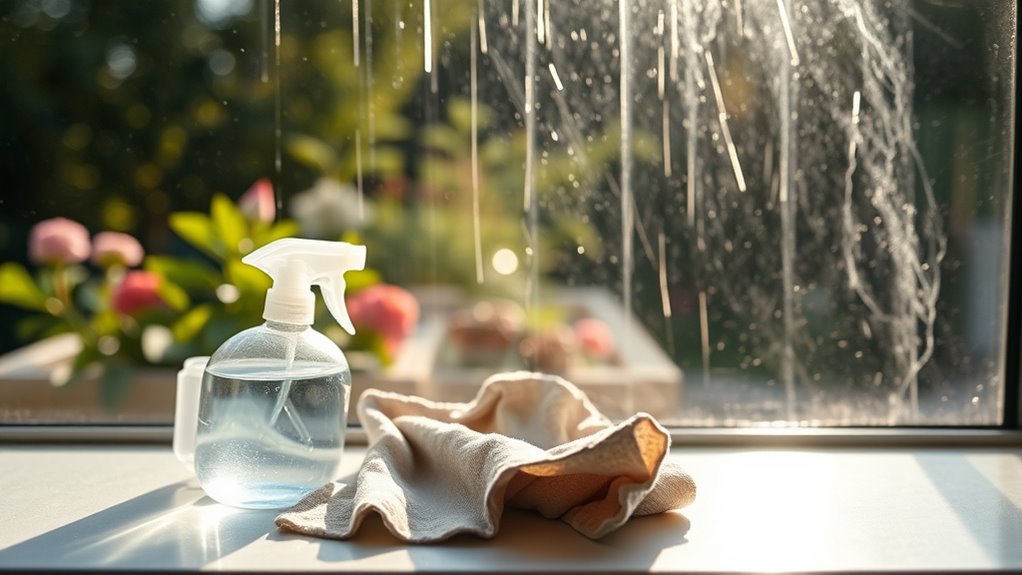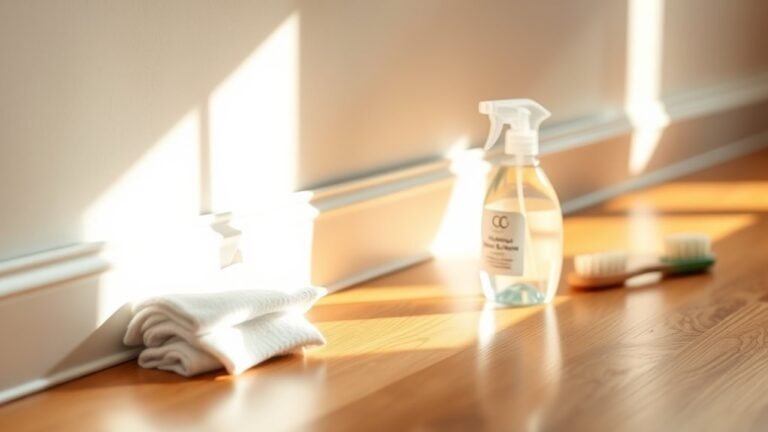Mistakes to Avoid When Cleaning Your Window
Don’t use harsh or ammonia-based cleaners—they can damage your windows and seals. Avoid cleaning in direct sunlight, which causes streaks from rapid drying. Always remove dust and dirt first to prevent scratches. Skip paper towels and use microfiber cloths for a streak-free finish. Don’t forget window tracks and frames, and avoid applying too much water or cleaner. Use a squeegee properly and prioritize safety, especially on high windows. There’s more to help you clean smarter and safer.
Using the Wrong Cleaning Solution
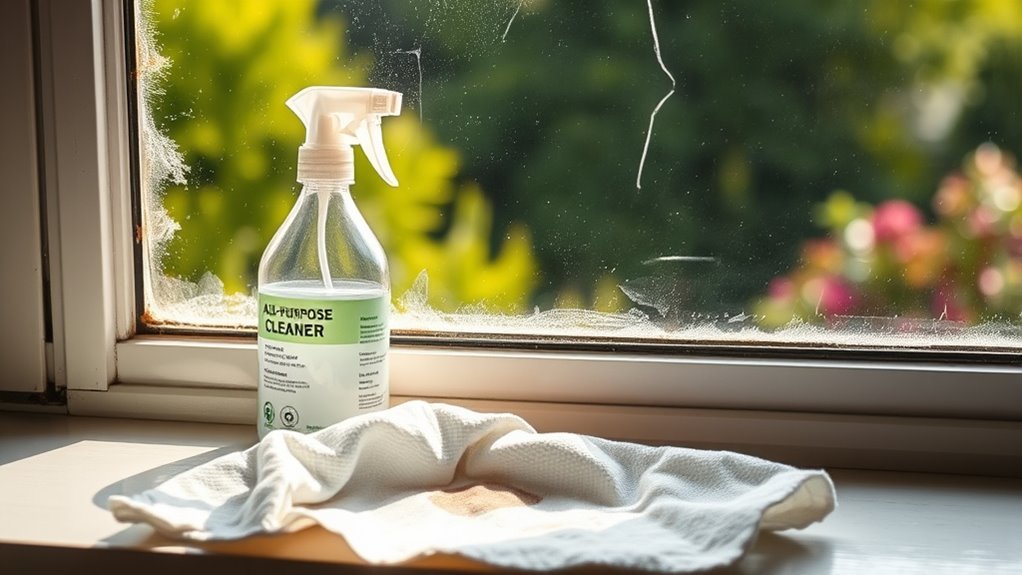
Although it might seem convenient to grab any cleaning product, using the wrong cleaning solution can damage your windows or leave streaks behind. Many commercial cleaners contain toxic chemicals that not only harm your glass but also affect your health and the environment. You don’t have to sacrifice freedom or safety—opt for natural alternatives like vinegar and water or castile soap mixtures. These solutions clean effectively without harsh residues, letting your windows shine clearly. Avoid ammonia-based products, as they can degrade window seals over time. By choosing the right cleaner, you protect your windows and maintain a healthier living space. Remember, freedom means making smart choices that work for you and the planet—start with what’s in your cleaning bottle.
Cleaning Windows in Direct Sunlight
When you clean windows in direct sunlight, the solution can dry too quickly, increasing the chance of streaks. This rapid drying makes it hard to wipe evenly, leaving unsightly marks behind. To avoid this, try cleaning during cooler parts of the day or in the shade.
Streak Formation Risks
Because direct sunlight heats the glass quickly, cleaning your windows in bright sun often leads to streaks. The heat causes cleaning solutions to dry too fast, leaving behind residue that forms those frustrating marks. To avoid this, focus on streak prevention techniques such as working in shaded areas or cleaning during cooler parts of the day. Using ideal cleaning tools also makes a big difference—microfiber cloths and squeegees help you remove dirt efficiently without leaving streaks. Avoid overusing cleaning solutions, as excess liquid contributes to streaking. By combining the right timing with proper tools and techniques, you’ll enjoy clear, spotless windows that let the light in without the hassle of unsightly streaks.
Quick Drying Challenges
If you clean windows in direct sunlight, you’ll often face quick drying challenges that make the job tougher. The sun causes cleaning solutions to evaporate rapidly, leading to streaks and uneven spots. To overcome this, use quick drying techniques like working in small sections and wiping immediately with a microfiber cloth. Timing is essential—clean when humidity levels are moderate since low humidity speeds evaporation, worsening streaks, while high humidity slows drying, reducing streak risk. Avoid spraying too much solution; a light mist works best. Also, consider cleaning windows early morning or late afternoon when sunlight is less intense. By understanding humidity effects and controlling drying speed, you’ll clean windows more effectively, freeing yourself from streaky, unsatisfactory results.
Neglecting to Remove Dust and Dirt First
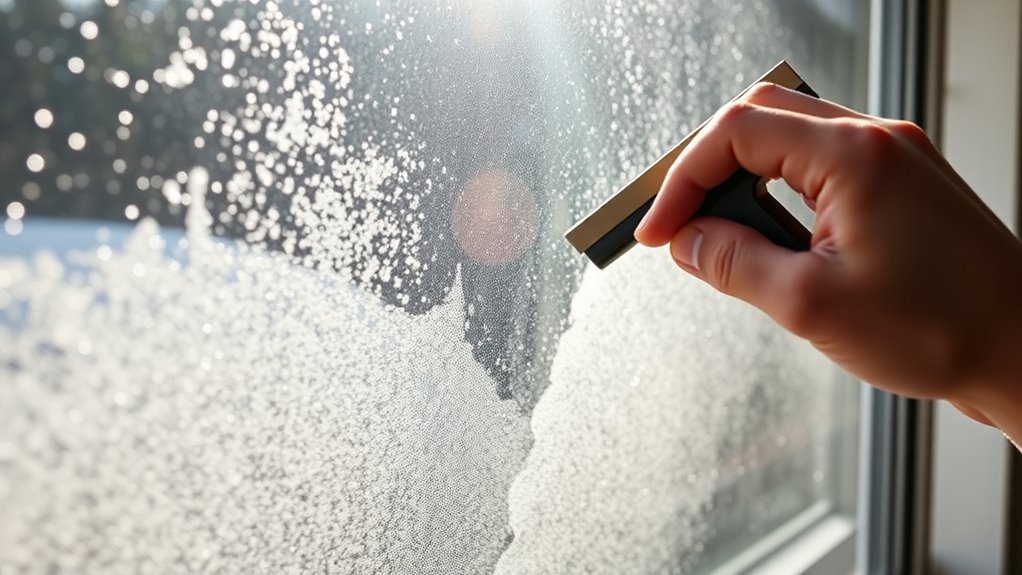
You should always remove dust and dirt before applying any cleaning solution to your windows. Skipping this step can cause grime to smear, making your windows look worse and harder to clean. Taking a moment to pre-clean guarantees a streak-free, clearer finish every time.
Importance of Pre-Cleaning
Although it might be tempting to jump straight into washing your windows, skipping the pre-cleaning step can cause more harm than good. The pre cleaning benefits go beyond just making your task easier—they guarantee effective preparation for a spotless finish. When you remove dust and dirt first, you:
- Prevent scratches from abrasive particles during washing.
- Avoid streaks caused by trapped grime.
- Save time by reducing the need for repeated cleaning.
- Extend your window’s lifespan by protecting its surface.
Effects of Skipping Dust Removal
Neglecting to remove dust and dirt before cleaning your windows can lead to multiple issues that compromise both the process and the results. Dust buildup acts like an abrasive layer, causing streaks and scratches when you wipe. This not only makes your windows look worse but also shortens their lifespan. Skipping this step forces you to scrub harder, wasting time and effort. Additionally, dust contains allergens and pollutants that can worsen indoor air quality. When disturbed during cleaning, these particles become airborne, posing health implications—especially for those with allergies or respiratory conditions. To maintain clear windows and a healthier environment, always start by removing dust and dirt with a soft brush or cloth. This simple step guarantees a smoother, more effective cleaning while protecting your well-being and freedom to enjoy your space.
Using Paper Towels Instead of Microfiber Cloths
One common mistake when cleaning windows is reaching for paper towels instead of microfiber cloths. You might think paper towels are convenient, but they come with drawbacks that limit your freedom to clean effectively. Microfiber benefits include superior absorption and streak-free results, which paper towels often fail to deliver. Plus, paper towels can leave lint behind and even cause scratches on delicate surfaces.
Avoid paper towels when cleaning windows; microfiber cloths absorb better and prevent streaks and scratches.
Here’s why you should switch:
- Microfiber traps dirt instead of spreading it.
- It dries faster, saving you time.
- Reusable microfiber reduces waste, protecting the environment.
- Paper towels often tear, requiring more effort and expense.
Choosing microfiber cloths gives you control over a cleaner, clearer window without the mess or hassle.
Forgetting to Clean Window Tracks and Frames
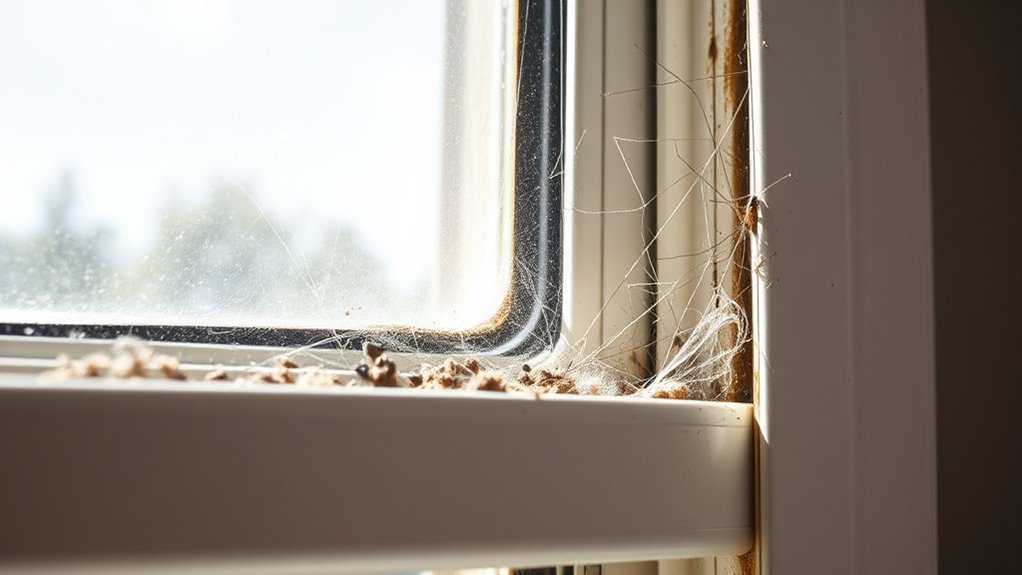
While microfiber cloths help you achieve spotless glass, cleaning only the window panes isn’t enough. You need to give attention to track maintenance and frame inspection to guarantee your windows function smoothly and last longer. Dirt and debris accumulate in window tracks, causing blockages and making sliding difficult. Use a vacuum or brush to clear out grime regularly. When inspecting frames, look for signs of damage, mold, or peeling paint. Addressing these issues early prevents costly repairs and preserves your window’s integrity. Neglecting tracks and frames limits your window’s efficiency and can affect insulation. By including track maintenance and frame inspection in your cleaning routine, you maintain freedom from frequent repairs and enjoy windows that operate effortlessly and look great.
Applying Too Much Water or Cleaner
Even though it might seem like more water or cleaner will get your windows spotless faster, using too much can actually cause streaks, residue, and damage to window components. Over saturation issues not only waste product but also lead to frustrating cleanup and potential harm to seals and frames. To keep your freedom from tedious rework, follow these guidelines for ideal cleaner amounts:
Using too much cleaner causes streaks, residue, and can damage window seals—less is truly more for spotless windows.
- Use a spray bottle with a fine mist to control liquid flow.
- Apply cleaner sparingly—less is more when battling dirt.
- Avoid drenching window edges to prevent moisture buildup inside.
- Wipe immediately with a microfiber cloth or squeegee to prevent streaking.
Skipping the Squeegee Technique
Controlling how much cleaner you use is important, but how you remove it matters just as much. Skipping the squeegee technique often leads to streaks and uneven drying, limiting your window’s clarity. Choosing the right squeegee sizes helps you tackle different window dimensions efficiently—small squeegees for tight spots and larger ones for expansive panes. Pay attention to squeegee angles; holding it at about 30 to 45 degrees optimizes water removal without scratching. Use smooth, overlapping strokes from top to bottom, wiping the blade after each pass. This method prevents drips and streaks, giving you a crisp, spotless finish. Mastering squeegee use frees you from frustrating cleanup and enhances your window-cleaning results every time. Don’t skip it—your windows deserve better.
Ignoring Safety Precautions on High or Hard-to-Reach Windows
When tackling high or hard-to-reach windows, neglecting safety precautions can lead to serious accidents. You want freedom, not injury, so don’t skip essential safety steps. Always wear proper safety gear like gloves and non-slip shoes. Check ladder stability before climbing—unstable ladders are a common hazard. Here’s what you must avoid:
- Using damaged or unsuitable ladders that compromise your balance.
- Cleaning windows alone without someone nearby to assist or call for help.
- Ignoring weather conditions that can make surfaces slippery or windy.
- Overreaching or leaning too far, risking a dangerous fall.
Respecting these precautions guarantees you stay safe and confident while cleaning, letting you enjoy the freedom of spotless windows without unnecessary risks.
Cleaning Windows Only When They Look Dirty
A window’s appearance can be deceiving if you only clean it when dirt is obvious. Waiting until grime builds up can make cleaning harder and reduce your window’s lifespan. Developing consistent window maintenance habits is key to preserving clarity and function. Regular cleaning prevents stubborn stains and damage caused by pollutants or hard water. Follow cleaning frequency tips by scheduling sessions every few weeks or monthly, depending on your environment. This proactive approach not only saves you effort in the long run but also keeps your view clear and your home feeling open and free. Don’t let visible dirt be your only cue; instead, treat window cleaning as routine upkeep essential for maintaining both beauty and durability.
Häufig gestellte Fragen
How Often Should I Deep Clean My Windows Annually?
You should aim for a window cleaning frequency of at least twice a year to keep things clear and bright. Deep clean your windows during seasonal window maintenance, ideally in spring and fall, to tackle grime buildup and prepare for changing weather. If you live in a dusty or rainy area, consider adding an extra cleaning session. This routine helps maintain your view and extends your windows’ lifespan without tying you down.
Can Window Tinting Affect Cleaning Methods?
Yes, window tinting definitely affects your cleaning methods. For proper tint maintenance, you’ll want to avoid abrasive tools or harsh cleaning solutions that can damage the film. Stick to gentle, ammonia-free cleaning solutions and use a soft cloth or sponge. This approach keeps your tint intact and looking fresh, giving you the freedom to enjoy clear, protected windows without worrying about scratches or peeling.
What’S the Best Time of Day to Clean Windows?
You’ll want to clean your windows during morning sunlight or evening shadows. Avoid midday when the sun’s heat causes cleaning solution to dry too fast, leaving streaks. Early morning or late afternoon light is gentler, letting you work without harsh glare and ensuring a streak-free finish. Choosing these times gives you more control, so your windows come out crystal clear, letting you enjoy your view without any smudges blocking your freedom.
Are There Eco-Friendly Alternatives to Traditional Window Cleaners?
Imagine your windows sparkling like morning dew kissed by sunlight. You can achieve this using eco friendly ingredients found in natural cleaners like vinegar, baking soda, and lemon juice. These simple, earth-friendly solutions cut through grime without harsh chemicals, giving you freedom from toxins. Mix equal parts water and vinegar in a spray bottle, add a few drops of essential oil for scent, and you’re set to clean windows safely and effectively, preserving both shine and planet.
How Do I Prevent Streaks on Tinted or Coated Glass?
To prevent streaks on tinted or coated glass, you’ll want to use streak free solutions specifically designed for delicate surfaces. Avoid harsh chemicals and abrasive tools that can damage the tint. Instead, try a mild, ammonia-free cleaner paired with a soft microfiber cloth. Apply tinted glass techniques like wiping in a circular motion and drying promptly to keep your windows clear and flawless, giving you the freedom to enjoy spotless views without worry.
